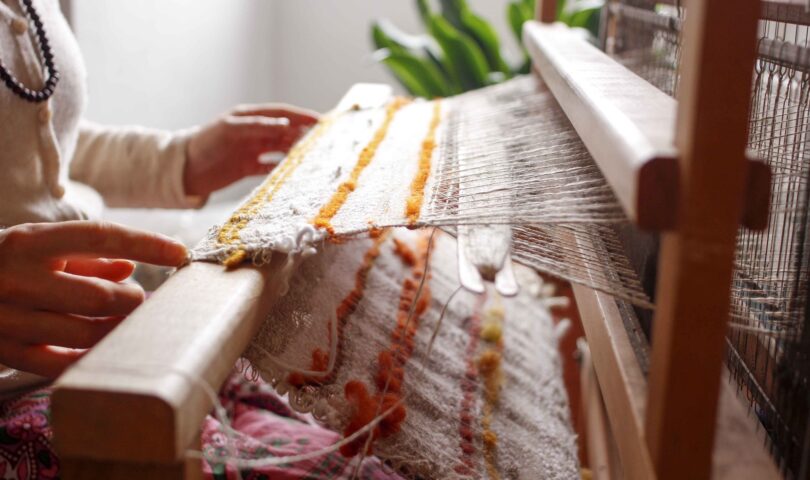Arthurdale boasts a rich history. Preserved in the basement of Arthurdale Heritage Inc.’s main building, 11 hidden gems speak to the community’s past and future. These meaningful and useful artifacts are looms.
According to AHI weaving teacher Linda Flemmer, Arthurdale homesteaders used several of the looms to make their own fabric for clothing, scarves, tablecloths and any other textile needs they had.
Homesteaders may even have woven a pattern on some of these looms that Linda has recently resurrected and has been weaving at AHI events to make two scarves the organization is raffling.
Arthurdale homesteader students used algebra to create the repeating plaid pattern with the equation (X+Y)^3 — and then turned the math into fabric using two colors of thread (assigning X or Y to each color).
At recent AHI events I gravitated to Linda, weaving a scarf with red and green worsted wool on a portable loom, a blue-and-white plaid scarf of the same algebraic pattern displayed nearby. I admire the art of weaving, so I wanted to see her work and hear her story.
“I started weaving about six years ago,” she told me, adding, “I took classes here at Arthurdale.” After the classes, she continued furthering her weaving skills on her own, before returning. “Now I teach here,” Linda said.
AHI offers classes for all ages and skill levels. Children can learn to weave a potholder, and adults can start with a similar small project. Adults wishing to continue their weaving studies after taking the first class, can apply to take longer and more advanced classes.
In these classes students design their own projects, and set up one of the 11 aforementioned looms themselves. Students need to apply for these positions because once they start a project, they tie that loom up until it’s finished — it’s usually not a quick process.
“There are a lot of people who are very interested [in weaving], but didn’t know where to go to learn,” Linda said.
She said the 11 vintage looms represent one of the benefits of learning to weave at AHI. They include different types of looms, exposing students to more than one weaving method. Along with the flexibility to create their own projects, students do more than follow a one-size-fits-all program.
Some of the looms at AHI were community donations; others are originals from the homesteading collective Eleanor Roosevelt initiated in 1934.
The original weaving building, where homesteaders created their fabric, burned down some years ago. Linda said a big, long-term project for AHI is to raise the funds to rebuild the weaving building.
Darlene Bolyard, executive director of AHI, said a smaller goal is to raise funds to improve the basement space where the looms are kept and used.
I was very excited to learn from Linda that so many people are interested in learning to weave. While I don’t weave myself, I have family members who do (including one who processed wool, spun it, wove cloth and sewed it into a coat). I also sew, and have an utmost respect for fabric. I wish I had a community-based and sustainable fabric source for my sewing needs.
If more people learn to weave and weave for their own household and even garment needs, maybe eventually these skills will revive and grow into a local trade. While it’s just a dream, the presence of the looms locally, and the fact that they are in regular use, allow me to sustain my wishful thinking.




